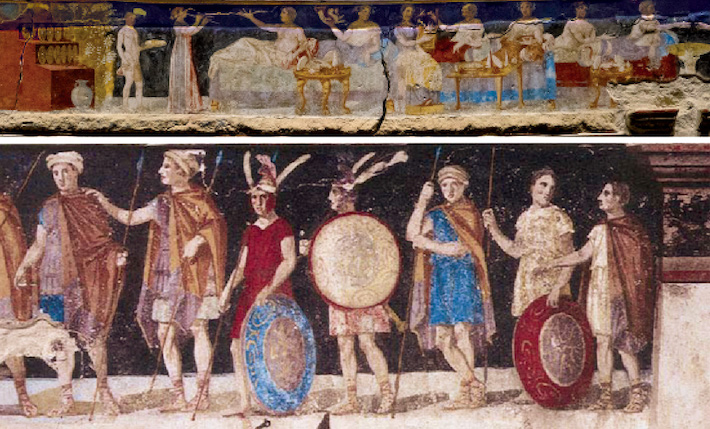 Archaeologists opened a window into the lives and appearances of the pages who attended the prestigious royal school of ancient Macedonia during excavations carried out decades ago. On the edge of the Greek village of Agios Athanasios, they discovered a large tomb dating to the last quarter of the fourth century B.C., whose facade is adorned with murals. A painted frieze depicting a drinking party runs along the facade’s upper section. In the image, six men recline on couches, their heads wreathed, a feast laid out before them. They enjoy wine from elaborate drinking vessels and music played by two female courtesans. On the right, several young men arrive at the party. They are attired in the distinctive dress of Macedonian soldiers—a cap called a kausia, a short cloak known as a chlamys, and tough leather boots called krepides. Scholars have identified the young men as either royal pages or new recruits to the army. Flanking the tomb’s door are two more young Macedonians, who stand guard over the dead. Each holds a sarissa, the distinctive type of long spear wielded by the Macedonian infantry, and visibly mourn the deceased. These are images of members of the generation that expanded Macedonian control across the known world under the leadership of Alexander the Great (reigned 336–323 B.C.).
Archaeologists opened a window into the lives and appearances of the pages who attended the prestigious royal school of ancient Macedonia during excavations carried out decades ago. On the edge of the Greek village of Agios Athanasios, they discovered a large tomb dating to the last quarter of the fourth century B.C., whose facade is adorned with murals. A painted frieze depicting a drinking party runs along the facade’s upper section. In the image, six men recline on couches, their heads wreathed, a feast laid out before them. They enjoy wine from elaborate drinking vessels and music played by two female courtesans. On the right, several young men arrive at the party. They are attired in the distinctive dress of Macedonian soldiers—a cap called a kausia, a short cloak known as a chlamys, and tough leather boots called krepides. Scholars have identified the young men as either royal pages or new recruits to the army. Flanking the tomb’s door are two more young Macedonians, who stand guard over the dead. Each holds a sarissa, the distinctive type of long spear wielded by the Macedonian infantry, and visibly mourn the deceased. These are images of members of the generation that expanded Macedonian control across the known world under the leadership of Alexander the Great (reigned 336–323 B.C.).
Time for School
